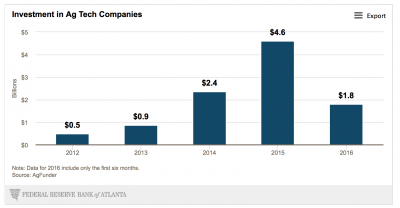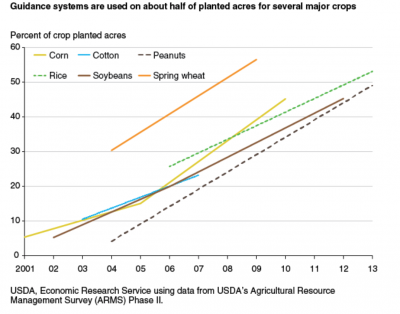Agriculture Secretary Brooke Rollins said on Tuesday that the Trump administration will announce a 'bridge payment' for farmers next week that is designed to provide short-term relief while longer trade…
Ag Technology: Increasing Availability and Use
An update yesterday from the Federal Reserve Bank of Atlanta (“Technology Reshapes Agriculture,” by Charles Davidson) indicated that, “When Joe Boddiford is in Atlanta, 200 miles from his Southeast Georgia farm, he can operate his irrigation systems with his smartphone. Boddiford can turn on the water to a particular set of nozzles or shut it off. He can activate an underground well or monitor the entire system. ‘That gives me a lot of peace of mind,’ says Boddiford, who grows cotton, peanuts, and corn on 2,200 acres about 60 miles from Savannah.
“One state over, north Alabama cotton grower Larkin Martin also relies on ‘precision agriculture‘ technologies. For example, monitors installed on cotton pickers measure the yield of Martin’s fields at three-foot intervals.”
#EconomyMatters looks at SE agriculture and finds that high tech has put down roots in farming https://t.co/mWhWKOkdXP pic.twitter.com/SYMxS76McG
— Atlanta Fed (@AtlantaFed) January 12, 2017
The Fed article explained that, “Like most large-scale commercial farmers, these southeastern growers have embraced what is known as precision agriculture. Today, these technologies are as common on big farms as pickup trucks: GPS-guided self-steering tractors, programmable boom sprayers that apply chemicals in precise quantities and locations, and smartphone apps that track, transmit, and analyze an array of data.
“Precision ag is not new. Soil sensors to measure organic matter came on the scene in the mid-1980s, and yield monitors began to proliferate in the 1990s. But the pace of ag technology investment and research and development (R&D) has quickened in recent years.
In fact, the U.S. Department of Agriculture noted that the past decade has brought ‘an explosion in the availability and use of information technology.’

Mr. Davidson noted that, “Devices and applications continue to improve. Technologies including drones, satellite mapping, and even the so-called Internet of things promise to influence agriculture in the 21st century. They’ll need to. Food production must become far more efficient if the world is to feed itself without inflicting great damage on the planet, says Kenneth Cassman, an emeritus professor of agronomy at the University of Nebraska Lincoln and an expert on agricultural water and resource usage.
The ‘grand challenge’ is to achieve a 50 to 100 percent increase in agricultural yields worldwide without increasing the net amount of existing farmland, Cassman points out in a 2016 article in the Federal Reserve Bank of Kansas City’s Economic Review.
Yesterday’s update also pointed out that, “Money has also poured into fledgling ag and food tech firms (see the chart). Investment in ag tech startups soared from $500 million in 2012 to $4.6 billion in 2015, according to AgFunder, a group that tracks agriculture-focused investing. Investment fell 20 percent during the first half of 2016 compared to the same period last year, as the larger venture capital market also declined.”

Meanwhile, an article from Amber Waves magazine (USDA- Economic Research Service) in December (“Precision Agriculture Technologies and Factors Affecting Their Adoption,” by David Schimmelpfennig) noted that, “Precision agriculture technologies are playing an increasing role in farm production. Precision technologies—such as tractor guidance systems using a global positioning system (GPS), GPS soil and yield mapping, and variable-rate input applications (VRT)—help farms gather information on changing field conditions to adjust production practices.
“U.S. farms adopted precision technologies at different rates and for different crops between 1998 and 2013. Guidance systems had the highest adoption—used in about half of planted acres for crops like corn, rice, and peanuts. GPS soil mapping and VRT lagged behind with adoption rates under 25 percent of planted acres.”

The Amber Waves article added that, “Empirical estimates found that these three technologies provided a small boost to farm profits for corn farms in 2010. For example, on average, VRT increased profitability by about 1 percent and GPS maps by almost 3 percent. Given the similar impacts on corn profits, farm operators might make the decision to adopt each precision technology based on its ease-of-use and functionality. Functionality (or usefulness) increases as a technology provides more information that operators can apply across a wide-range of production practices. Guidance systems have high ease-of-use, while yield and soil maps have high functionality. VRT appears to be low in both ease-of-use and functionality.”





